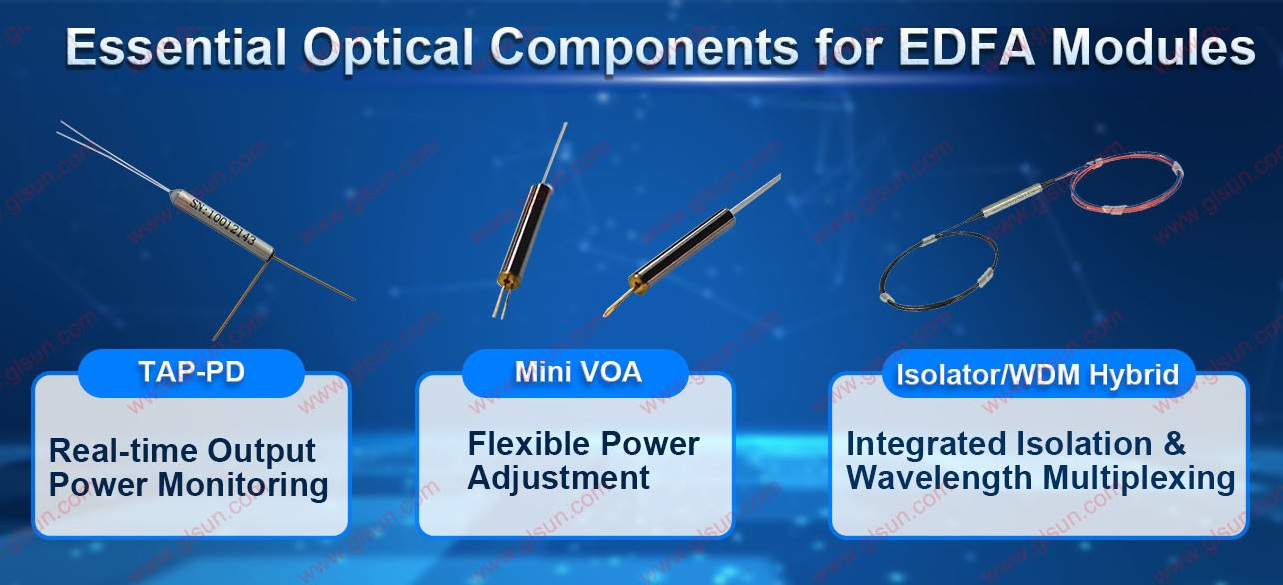Optimizing EDFA Systems with TAP-PD, Mini VOA, Isolator, and WDM Integration
2025-07-19
Erbium-Doped Fiber Amplifiers (EDFAs) have become the default solution for optical signal amplification in dense wavelength division multiplexing (DWDM), CATV, and long-haul fiber networks. But their consistent performance depends not only on the gain fiber and pump lasers, but also on a precise combination of supporting components. From real-time power monitoring to optical protection and wavelength routing, modules such as TAP-PD, Mini VOA, optical isolators, and WDMs play critical roles behind the scenes.
TAP-PD: Power Monitoring and Feedback Control
In any amplification system, monitoring signal strength is essential, and within EDFAs, this function is typically handled by a TAP-PD module. This component consists of a tap coupler that diverts a small fraction of the optical signal and a photodiode that measures the power level of that tapped light. By providing real-time data on signal intensity at both the input and output ends of the amplifier, TAP-PD modules enable precise monitoring and feedback control. This monitoring capability forms the foundation for closed-loop functions such as Automatic Gain Control (AGC) and Automatic Power Control (APC), ensuring that the EDFA adapts to fluctuations in input power and maintains consistent performance. Additionally, the TAP-PD module allows remote diagnostic systems to detect failures or performance drifts early, reducing downtime and enhancing system reliability.
Mini VOA: Dynamic Gain Management
As signal conditions change along a transmission path, EDFAs must dynamically adjust their gain to avoid distortion or saturation. This is where the Mini Variable Optical Attenuator (Mini VOA) becomes essential. Unlike fixed attenuators, Mini VOAs offer precision tuning of signal power within compact form factors suitable for board-level integration. Positioned within the amplifier chain, these devices regulate output power by introducing variable loss, effectively controlling the gain delivered to downstream equipment. In multi-channel systems, particularly DWDM networks, Mini VOAs are also used to equalize signal levels across channels, thereby optimizing Optical Signal-to-Noise Ratio (OSNR) and reducing inter-channel crosstalk. Their ability to react swiftly to changes in network conditions makes them vital for maintaining service quality, especially in networks where performance guarantees are critical.
Optical Isolators: Protecting the EDFA Core
Optical isolators are another critical element in any high-performance EDFA. Their primary function is to allow light to pass in only one direction—preventing any reflected signals from propagating back into the amplifier. Back-reflected light, often caused by connector mismatches, fiber discontinuities, or component interfaces, can destabilize the erbium gain medium, introduce noise, and even damage sensitive components such as pump lasers. By inserting isolators at the input and output stages of an EDFA, engineers can effectively safeguard the amplifier’s internal components and maintain unidirectional signal flow. This is especially crucial in CATV or access networks, where fluctuating return loss is common. In integrated designs, isolators are often combined with other components like WDMs to save space while preserving essential protective functions.
WDM Components: Managing Pump and Signal Pathways
Efficient wavelength management is fundamental to the operation of EDFAs, which require external pump lasers—typically at 980 nm or 1480 nm—to excite the erbium ions in the doped fiber. Wavelength Division Multiplexers (WDMs) are used to combine these pump wavelengths with the signal light (usually in the C-band) without introducing significant insertion loss. On the input side, WDMs inject pump light into the erbium-doped fiber alongside the signal, initiating the amplification process. At the output, WDMs may also be employed to filter out residual pump power or to manage supervisory wavelengths for advanced monitoring. By enabling multi-wavelength routing within a compact optical path, WDM components are central to achieving the low-noise, high-efficiency performance expected of modern EDFA modules.
Toward Compact and Integrated EDFA Modules
As optical networks scale, the demand for miniaturized, power-efficient, and intelligent amplifier modules continues to grow. To meet these requirements, manufacturers are increasingly developing integrated optical subassemblies that combine TAP-PD, Mini VOA, isolators, and WDMs into a single compact unit. This approach not only saves space but also reduces insertion loss by shortening internal fiber paths and minimizing connector interfaces. Additionally, integrated modules allow for improved thermal management and greater mechanical robustness, resulting in higher system MTBF and lower total cost of ownership. From a manufacturing perspective, integrated EDFA modules streamline assembly and testing, making them ideal for high-volume deployment in data centers and telecom backbones.

In Dense Wavelength Division Multiplexing (DWDM) systems, EDFA modules equipped with Mini VOAs and TAP-PDs enable dynamic per-channel power balancing and real-time performance monitoring—key requirements for maintaining flat gain profiles across multiple wavelengths. In CATV networks, where return loss can be unpredictable, isolators ensure stable signal delivery without risking damage to sensitive laser sources. For access networks like FTTx, compact EDFA designs with integrated WDMs and monitoring allow operators to remotely adjust and maintain performance, significantly reducing the need for on-site interventions. These real-world scenarios demonstrate how critical these auxiliary components are—not just in supporting EDFA functionality but in defining network scalability and service quality.
While the erbium-doped fiber and pump lasers are the heart of any EDFA system, it is the supporting components—TAP-PD modules, Mini VOAs, Optical Isolators, and WDM multiplexers—that enable precision, stability, and protection. These components ensure that amplification is not only effective but also safe, controllable, and responsive to real-time network dynamics. In an era where optical networks must deliver more bandwidth over longer distances with minimal latency, the integration and optimization of these auxiliary devices are more important than ever. For network designers and optical equipment manufacturers, investing in high-quality EDFA components is a strategic decision that pays off in reliability, performance, and customer satisfaction.







